Most Valuable Vinyl Records
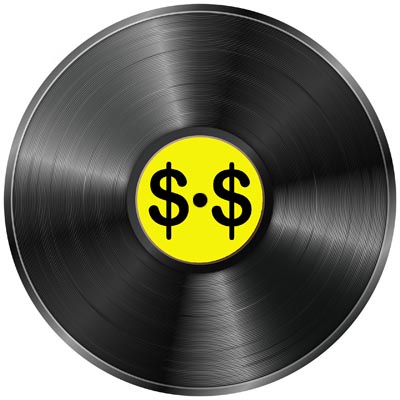 Vinyl records have made a comeback in recent years, and as a result, people are often searching for information about them online. One of the most popular searches, oddly enough, is for the phrase most valuable vinyl records.
Vinyl records have made a comeback in recent years, and as a result, people are often searching for information about them online. One of the most popular searches, oddly enough, is for the phrase most valuable vinyl records.
People know that some records are more valuable than others, and that many records are quite expensive. As a lot of people are now giving thought to the boxes of records in their attic or basement that they haven’t touched in decades, it makes sense that they might have a curiosity as to whether they personally own any of the most valuable vinyl records.
The short answer is – they don’t, and neither do you. That’s not because you don’t have good taste in records or that you simply bought the wrong ones in the store all those years ago.
The real reason that you, or any randomly selected individual, don’t own any of the most valuable vinyl records is because, with few exceptions, nearly all of the most valuable vinyl records are highly unusual, one-of-a-kind items.
We’re talking about things like Elvis Presley’s cut-with-a-lathe acetate of “My Happiness”, or the one acetate of “That’ll Be the Day” by the pre-Beatles Quarrymen, or the intentionally pressed-in-a-quantity-of-one albums by the Wu Tang Clan (Once Upon a Time in Shaolin) or Jean-Michele Jarre (Music for Supermarkets).
Those records are indeed the most valuable vinyl records, but they’re all unique, aren’t likely to change hands anytime soon, won’t be affordable if they do, and aren’t records that anyone reading this article actually own.
We suspect that when people do a search for “most valuable vinyl records”, what they really want to know is “Do I personally own any of the world’s most valuable vinyl records?” We know that when we bought our first record price guides back in the late 1970s, the first thing we did was look up records we owned to see if we had anything that was worth a lot of money.
Featured Products
-
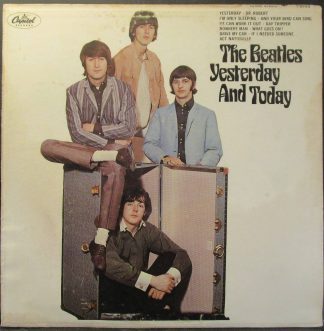
Beatles – Yesterday and Today 1966 U.S. mono Second State Butcher cover LP COA
$995.00Free U.S. shipping! An original mono "second state" or "pasteover" U.S. Butcher cover copy of Yesterday and Today by the Beatles with the cover still in the original shrink wrap.Add to cart -
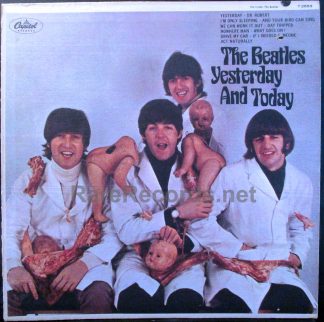
Beatles – Yesterday and Today 1966 U.S. mono Third State Butcher cover
$2,795.00Free U.S. shipping! A professionally peeled mono "third state" U.S. Butcher cover copy of Yesterday and Today by the Beatles.Add to cart -
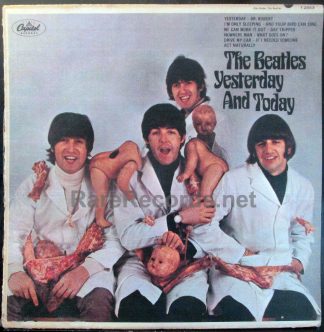
Beatles – Yesterday and Today 1966 U.S. mono Third State Butcher cover
$1,895.00Free U.S. shipping! A mono peeled "third state" Butcher cover copy of Yesterday and Today by the Beatles.Add to cart
Click here to browse some of the rarest records we have in our store.
We didn’t, of course, and that’s because nearly all of the top 100 of the world’s most valuable vinyl records are individually cut acetates, test pressings, pre-production (not commercially released) items that were never formally released, or other items that likely would only have been available to record company employees or in some cases, only to the artists themselves. A few other items on the list are ultra-rare pre-World War II blues 78s and ultra-rare 45 RPM singles that were released on tiny regional record labels and were quickly forgotten.
That being the case, we put this article together to list some of the world’s most valuable vinyl records, but with a bit of a twist. This article will cover the rare and the valuable, but only record albums, and only albums that were actually commercially available. We’re leaving out the 45 and 78 RPM singles because on this site, we focus on albums, so we’ll restrict the list to that format only.
That is, these are albums that were, at least in theory, sold in stores and records to which the general public might have been able to purchase at one time or another.
We’ll list 10 of the world’s most valuable vinyl records, more or less in order of value. Keep in mind that these are prices for items that have been sold publicly. Obviously, private sales are just that, and we have no idea as to the sorts of deals that may have gone on between private collectors.
World’s Most Valuable Records – The Top 10
It likely won’t surprise most readers to see that a majority of the most valuable vinyl records are by the Beatles. They are perhaps the most heavily collected artist, and the single biggest-selling band of all time. With that kind of interest, it only stands to reason that a number of albums by the Beatles would appear on a list such as this one.
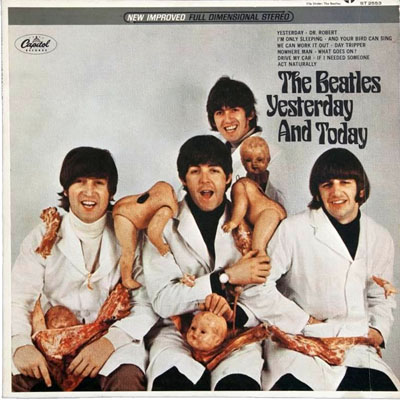
Beatles – Yesterday and Today sealed stereo “first state” Butcher cover (1966) – $125,000 – The infamous withdrawn pressings of the Beatles 1966 American LP Yesterday and Today are perhaps the most sought out album in history. The album was intended to be released with a photo that depicted the Beatles dressed in butcher smocks, posing with chunks of raw meat and parts of disassembled toy dolls. This cover became known as the “Butcher Cover.”
The response to review copies of the album was hostile, and stores were threatening not to stock the album when it was formally released to the public. Capitol Records changed their mind about the cover and printed new ones…which they then pasted over the photo with the dolls.
While the covers with the second cover pasted over the first one, known as “second state” Butcher covers, are collectible, the “first state” covers that never had the second cover pasted over it are among the rarest and most valuable of all records. Most of the review copies were sent back to the record company at their request, though it appears that a handful of copies were sold at retail in Southern California. Mono copies are considerably rarer than their stereo counterparts, and only a handful of copies survive today in pristine, still-sealed (unopened) condition.
There may be a few dozen sealed mono copies in existence, but there are likely fewer than 10 known sealed stereo copies, and one of them sold for $125,000 in 2016.
While a sealed stereo “first state” Butcher cover can sell for six figures, even a mint one can sell for considerable amounts of money, and copies have sold for more than $15,000
Mono sealed copies, mono or stereo opened copies, intact second state copies and peeled “third state” copies of this album sell for considerably less, sometimes for as little as $100, depending on condition.
Click here to read a more comprehensive article about the Beatles Butcher cover.
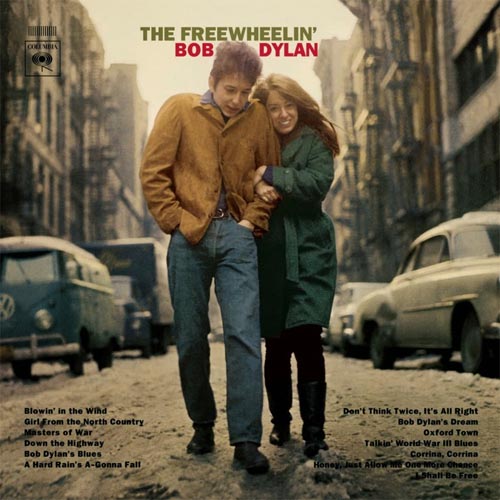 Bob Dylan – The Freewheelin’ Bob Dylan with withdrawn tracks (1963) $35,000 – Bob Dylan’s first album, released in 1962, drew some critical notice but didn’t sell well enough to make the Billboard charts. His second album, The Freewheelin’ Bob Dylan, on the other hand, drew attention and sold well enough to reach #22 on the American Billboard album chart.
Bob Dylan – The Freewheelin’ Bob Dylan with withdrawn tracks (1963) $35,000 – Bob Dylan’s first album, released in 1962, drew some critical notice but didn’t sell well enough to make the Billboard charts. His second album, The Freewheelin’ Bob Dylan, on the other hand, drew attention and sold well enough to reach #22 on the American Billboard album chart.
The album consisted mostly of self-written material, including the now-classics “Blowin’ in the Wind” and “Don’t Think Twice, It’s All Right.”
The album was issued in both mono and stereo, but at Dylan’s request, four songs were withdrawn from the album shortly before release and replaced with new ones.
The intended original album contained the songs:
- “Rocks and Gravel”
- “Let Me Die in My Footsteps”
- “Gamblin’ Willie’s Dead Man’s Hand”
- “Talkin’ John Birch Blues”
These songs were replaced with:
- “Girl From the North Country”
- “Masters of War”
- “Bob Dylan’s Dream”
- “Talkin’ World War III Blues”
Even though the original version of the album was ready for release, new stampers were manufactured with the new songs, and the album shipped to stores on the scheduled day of release with the second set of songs.
It appears, however, that at some point during the early days of manufacturing the album, a few copies were accidentally pressed using the stampers for the original intended version of the album. On the mono copies, the labels listed the second set of songs, but actually played the withdrawn tracks. These can be identified by either playing the record or by examining the stamped numbers in the “dead wax” area near the label. The numbers on the rare version of the album end in -1, followed by a letter. Later pressings have “2” (or higher) as the final digit.
Only a dozen or so mono copies have been found so far, and only two copies have been found in stereo. The stereo pressings are easier to identify, as not only do the records play the original songs, but the labels also list the original songs.
Mono copies have sold for as much as $12,000, but one of the two known stereo copies sold a few years ago for $35,000. As these were pressed by mistake, these copies may very well have found their way into record stores back in 1963, and it’s possible that more copies are still out there.
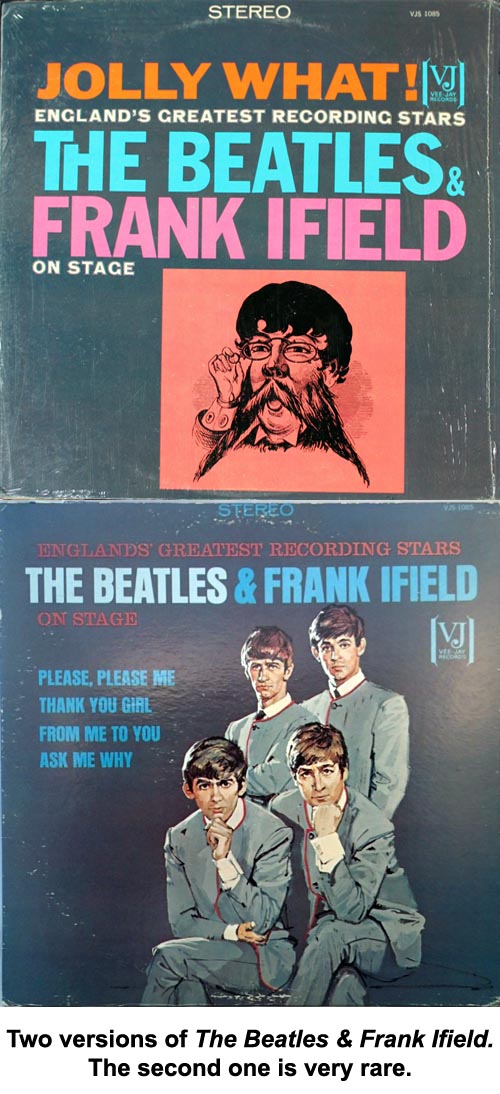 The Beatles and Frank Ifield On Stage (1964) $30,000 – When the Beatles first started releasing records in Britain, their UK label, Parlophone, offered their contract to the label’s American counterpart, Capitol. Capitol declined the offer, as English acts hadn’t sold particularly well in the U.S. up to that point.
The Beatles and Frank Ifield On Stage (1964) $30,000 – When the Beatles first started releasing records in Britain, their UK label, Parlophone, offered their contract to the label’s American counterpart, Capitol. Capitol declined the offer, as English acts hadn’t sold particularly well in the U.S. up to that point.
Tiny Vee Jay Records ended up with the contract. They released a few singles that went nowhere, and gave up. When Capitol announced their intentions to release the Meet the Beatles album in early 1964, Vee Jay realized that they had a bunch of Beatles material sitting in their vaults.
A lawsuit from Capitol prohibited Vee Jay from releasing any Beatles product after October, 1964, but between January and October of that year, they released Introducing the Beatles, Songs, Pictures and Stories of the Beatles (a reissue of that album with a different title), The Beatles vs. The Four Seasons (that album again, along with a Four Seasons LP) and Jolly What! The Beatles and Frank Ifield.
Frank Ifield was an English singer whose biggest hit was “I Remember You,” which reached #5 on the U.S. charts in 1962. The Jolly What! The Beatles and Frank Ifield LP was a collection of eight songs by Ifield, along with four tracks by the Beatles: “Please Please Me”, “From Me to You”, “Ask Me Why”, and “Thank You Girl”.
That album was released in February, 1964 with a cover depicting a drawing of an old man with a mustache wearing a Beatle wig. The album sold poorly, and in October of that year, looking for a last-minute boost in sales before their rights to sell Beatles records went away, Vee Jay made some changes to the album:
- The title was changed, dropping the “Jolly What!”, but retaining the “On Stage,” suggesting that the album was a live recording, which it was not.
- All four Beatles song titles (but none by Ifield) were listed on the cover
- The cover was changed to one with a drawing of the four members of the Beatles
- “The Beatles” was printed in a lighter, easier-to-read font than was “Frank Ifield”
The new cover was only available for a few weeks and while exact pressing figures are unknown, it’s likely, based on sales over the years, that only a few hundred mono copies were pressed, and likely fewer than 100 stereo copies were pressed.
The version of the album with the old man on the cover is rare, and copies sell in the $100-$400 range, depending on condition and whether they are mono or stereo.
Mono copies of the second cover are rare and sell in the $5000-$10,000 range. The stereo pressing is one of the most valuable vinyl records sold in the U.S. by the Beatles and a sealed copy was offered for sale a few years ago by a prominent Los Angeles record store for $30,000.
Those looking to cash in should be aware that both the mono and stereo copies of this album have been counterfeited, with most counterfeit copies lacking the printing of the album’s title on the spine of the cover.
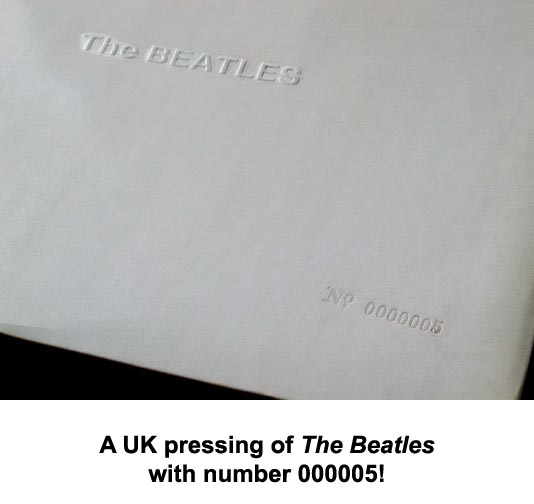 The Beatles – The Beatles (aka “The White Album”) low-numbered copies (1968) $10,000+ – After the 1967 LP Sergeant Pepper’s Lonely Hearts Club Band, an album that had an unusually elaborate cover, the Beatles went minimalist on their 1968 follow-up. Titled simply The Beatles, the album had a cover that was all white, though the name of the band was embossed on the cover.
The Beatles – The Beatles (aka “The White Album”) low-numbered copies (1968) $10,000+ – After the 1967 LP Sergeant Pepper’s Lonely Hearts Club Band, an album that had an unusually elaborate cover, the Beatles went minimalist on their 1968 follow-up. Titled simply The Beatles, the album had a cover that was all white, though the name of the band was embossed on the cover.
In addition, every copy of the album sold during its initial release was individually numbered. Multiple copies were made in both the U.S. (in stereo only) and in the UK (in mono and in stereo) bearing #1. These were given to members of the group and to high-ranking record company employees.
A few years ago, Ringo Starr sold his personal mono copy with #1 on it in an auction and it sold for $750,000!
All other copies were consecutively numbered (though various numbering systems were used) on both U.S. and UK pressings and copies numbered into the millions. One would think that since every copy bears a unique number that all copies should share equal value, but collectors are particularly interested in finding copies that have low numbers.
Pricing can vary dramatically for numbered copies of The Beatles depending on the number. A mint copy with a six or seven digit number might sell for $100 or so, but copies numbered under 100,000 draw higher prices, and the prices increase substantially for copies lower than 10,000, 1000, or 100. In 2008, a UK copy with #5 sold for £19,201 (about $27,000 U.S.) and we recently saw a U.S. copy with number 32 offered for sale for $10,000.
While copies numbered under 100 were likely all issued to record company employees, it’s possible that numbers above that were sold to the public and these could sell for anywhere from $1000-$10,000, depending on the number.
The Beatles was sold with numbered copies in a number of different countries besides the U.S. and the UK, and prices will vary widely depending on the country and the number. Still, there are a lot of low-numbered copies out there, and The Beatles is one of those rare cases where you might just have one of the world’s most valuable vinyl records sitting in your closet.
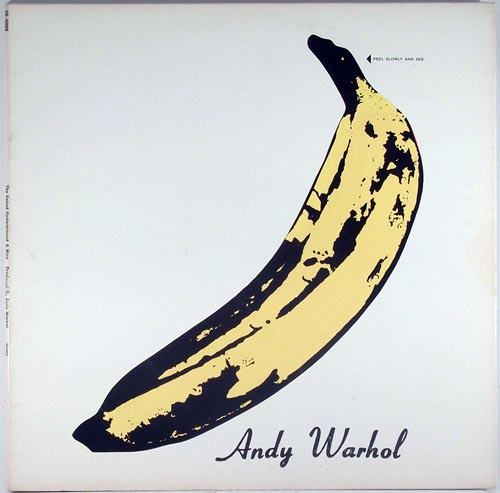 The Velvet Underground & Nico – The Velvet Underground & Nico (1966) stereo pressing without the song “Sunday Morning” $22,000 – The 1966 debut by the Velvet Underground, the self-titled The Velvet Underground & Nico, sold poorly but remains one of the most influential albums of all time.
The Velvet Underground & Nico – The Velvet Underground & Nico (1966) stereo pressing without the song “Sunday Morning” $22,000 – The 1966 debut by the Velvet Underground, the self-titled The Velvet Underground & Nico, sold poorly but remains one of the most influential albums of all time.
The album featured a banana on the cover in the form of a sticker and printed above it were the words “Peel slowly and see.” Many people did just that, and it’s hard to find an original copy of that album in either mono or stereo that still has a fully intact banana.
Copies of The Velvet Underground & Nico in mint condition with a complete banana have sold for upwards of $1000, but in 2017, a previously-unknown variation of the LP came up for sale. This version was missing the song “Sunday Morning,” which would ordinarily have been the first song on side one of the album.
The cover and label of this particular U.S. pressing did list that song title, but the record did not include the song on it. Apparently, the album was originally intended to be released without the song, but it was added at the last minute and new stampers were made. As with The Freewheelin’ Bob Dylan, a few copies appear to have been pressed with the earlier stampers by mistake, creating an ultra-rarity.
The only copy known to date sold for $22,000 in 2017, which would certainly qualify it as one of the most valuable vinyl records and was a stereo copy. Most stereo copies of the album have the letters “REV” (for revision) etched in the dead wax area near the label on side one. Copies of this ultra-rare version can be identified by either playing the record, where “I’m Waiting for the Man” would be the first song, rather than “Sunday Morning.” Alternatively, the record can be identified by the lack of “REV” in the dead wax on side one.
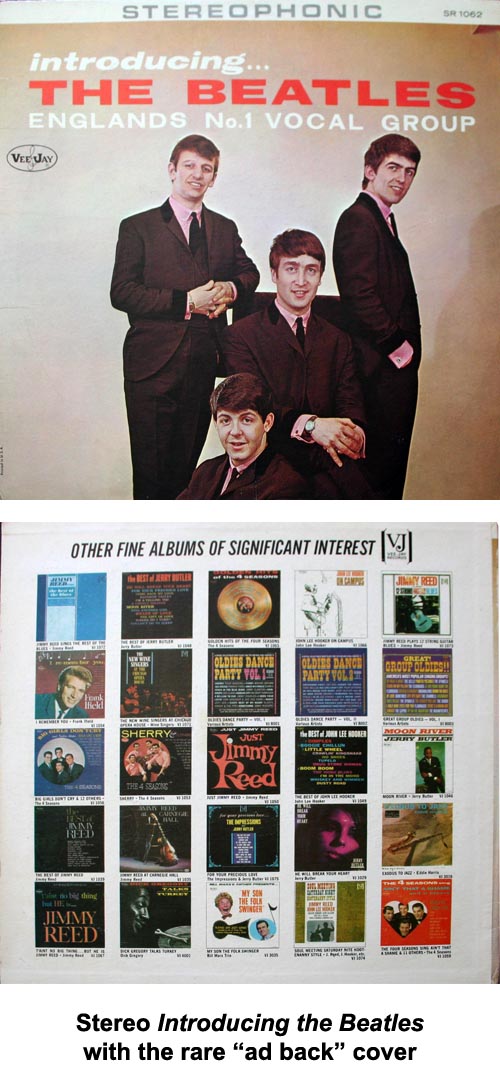 The Beatles – Introducing the Beatles stereo with “ad back” cover (1964) $15,000 – Yes, another Beatles album, and another album from the misfit label Vee Jay. Vee Jay had acquired the rights to an album’s worth of Beatles songs (released as Please Please Me in the UK) in 1963, but due to the poor sales of several singles, the label, which was strapped for cash, decided not to release the album.
The Beatles – Introducing the Beatles stereo with “ad back” cover (1964) $15,000 – Yes, another Beatles album, and another album from the misfit label Vee Jay. Vee Jay had acquired the rights to an album’s worth of Beatles songs (released as Please Please Me in the UK) in 1963, but due to the poor sales of several singles, the label, which was strapped for cash, decided not to release the album.
When Capitol released “I Want to Hold Your Hand” and announced the release of Meet the Beatles in January, 1964, Vee Jay remembered that they had the unreleased album in their vaults and quickly rushed to release it to the public.
The label titled the album Introducing the Beatles and quickly put together a front cover with a photo of the band, but they were in such a rush to get the album to stores that they didn’t bother to create a back cover for the album. First pressings of the album, issued in both mono and stereo, list no song titles anywhere on the cover. The back cover of the album shows pictures of 25 other Vee Jay albums, but has no information about either the group or the contents of the record.
About the same time, Vee Jay also released a few copies of the album that had blank white back covers. This may have been a production error. Within a couple of weeks, a “proper” album cover listing song titles was added to the album, and a couple of weeks later, that back cover was changed as two songs (“Love Me Do” and “P.S. I Love You”) were dropped from the album and replaced with two others (“Please Please Me” and “Ask Me Why.”
The first version of Introducing the Beatles with the 25 cover photos on the back cover is known as the “ad back” cover and the version with no printing at all is known as the “blank back” cover.
The “ad back” version is the more valuable, as it’s both harder to find and is considered to be the original pressing of the album. Stereo copies have sold for as much as $15,000, putting them among the most valuable vinyl records, and mono copies have sold for about half that price. As Vee Jay pressed about 50 mono records for every one in stereo, the stereo version is a relative bargain.
“Blank back” copies sell for $3000-$5000, depending on whether they are mono or stereo, but finding a blank back copy without a lot of cover wear is quite difficult.
While Introducing the Beatles is the most heavily counterfeited album of all time, most of the counterfeit copies of this album are of later pressings. We are not aware of counterfeit copies of either the ad back or blank back versions of this album.
Be aware that due to the large number of counterfeits of this album, most people believe that Introducing the Beatles is actually a fairly common album. That’s not the case; it’s rather rare and exceptionally so in stereo.
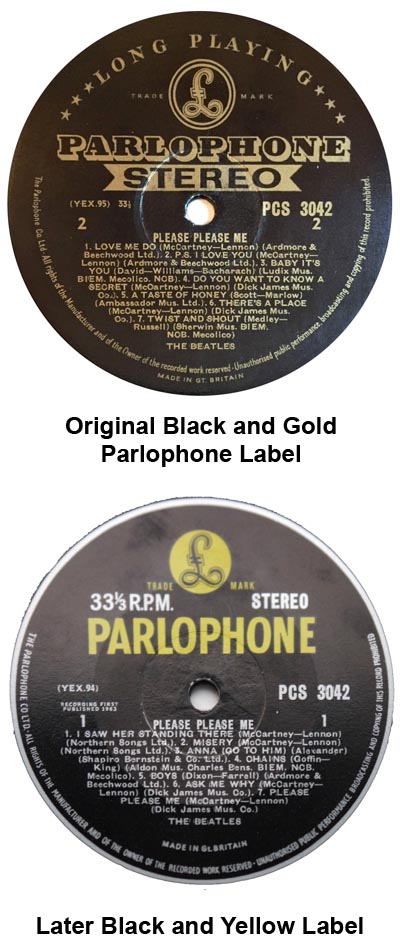 The Beatles – Please Please Me UK stereo with black and gold label (1963) $21,000 – The Beatles first album, Please Please Me, was released in Britain nearly a year before its U.S. release as Introducing the Beatles. The album was initially released in March, 1963 in the UK on the Parlophone label, and first pressings were available only in mono.
The Beatles – Please Please Me UK stereo with black and gold label (1963) $21,000 – The Beatles first album, Please Please Me, was released in Britain nearly a year before its U.S. release as Introducing the Beatles. The album was initially released in March, 1963 in the UK on the Parlophone label, and first pressings were available only in mono.
A month later, stereo copies were released, and like the mono, the label used on the record was the then-current black Parlophone label with gold print. Shortly after the stereo release, Parolophone changed their label artwork to a black label with yellow and white print, and that label was used for all subsequent pressings of the album through 1969.
At the time, mono records typically outsold stereo pressings by a ratio of nearly 100:1, as most buyers did not own stereo phonographs. While mono pressings sold fairly well when the album was first released, stereo copies did not, and it is estimated that fewer than 1000 stereo copies were sold with the black and gold label before Parlophone changed label designs, making the first-issue stereo pressings quite rare, given that the album eventually sold millions of copies.
While original mono copies are rare, it’s the stereo pressings that qualify as being among the world’s most valuable vinyl records.
Finding an original stereo UK pressing of Please Please Me is quite difficult, but it’s even harder to find a copy in collectible condition, as most people who bought the album played it until it was worn out. Mono copies turn up for sale fairly frequently, but stereo copies are much harder to find and much more expensive.
In 2014, a stereo copy in exceptional condition sold on eBay for £14,994, or about $21,000 in 2018 dollars.
 Stonewall – Stonewall (1976) $14,000 – You may not have ever heard of a band called Stonewall, and that’s not surprising. They released only one album, the self-titled Stonewall in 1976, and it’s not even fair to suggest that that album was even properly released.
Stonewall – Stonewall (1976) $14,000 – You may not have ever heard of a band called Stonewall, and that’s not surprising. They released only one album, the self-titled Stonewall in 1976, and it’s not even fair to suggest that that album was even properly released.
Stonewall was issued by the small Tiger Lily record label, and Tiger Lily is known among record collectors as a “tax scam” label. Tiger Lily was apparently run by Morris Levy, who was also the president of Roulette Records. Under tax laws in effect in the 1970s, record labels could charge recording, pressing and distribution costs against profits.
Tiger Lily was apparently set up for the express purpose of not making money. The label solicited tapes from a variety of artists who thought they might get a record deal. Ordinarily, when record companies solicit tapes, they listen to them, find artists the like, sign them to a contract, and put them into a studio to record an album.
Tiger Lily Records apparently took a different approach. They asked for tapes, cut records from them and released the albums without any effort to promote them and often without even informing the artists and certainly without paying them their due royalties. Most of the titles were pressed in small runs of a few hundred copies, and then then were deleted from the catalog.
Most Tiger Lily albums purchased by the public were likely found in the discount bins.
In the meantime, Tiger Lily fabricated recording and distribution “costs” which they used to offset profits at the main label, Roulette.
The 60+ known albums released by Tiger Lily covered the full spectrum of music, from pop to country to hard rock. Everything released by the label is collectible to some degree, but some records are harder to find (and contain better music) than others.
Stonewall was an album by a hard rock group if the same name, and the album compares favorably to a number of better-known hard rock acts of the era, such as Grand Funk Railroad or Cream. Their lone album is also one of the hardest titles to find on the Tiger Lily label, and in 2014, a copy of the album was sold on eBay for $14,100.
We’ve never seen a copy and we don’t know anyone who has, but there have to be more copies out there than the handful that have turned up to date. While it’s likely that future copies that turn up will sell for less money than $14,000, the album still qualifies as one of the most valuable vinyl records sold to date.
It’s also a pretty good album, and it has since been legitimately reissued.
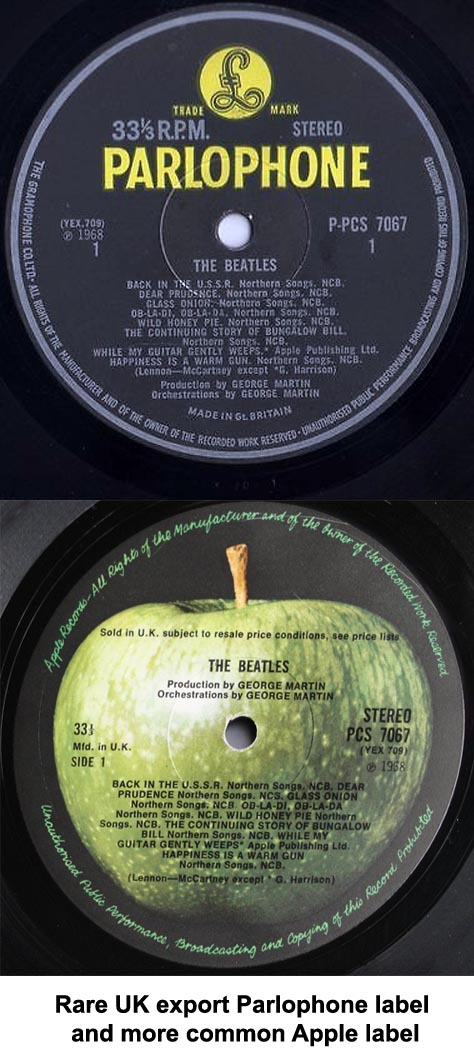 The Beatles – The Beatles (aka “The White Album”) UK export copies (1968) $10,000+ – Yes, the White Album appears on this list again. This time, it’s not the number on the cover that matters (though it might affect the price.) This particular version of the White Album is the version that Parlophone Records in Britain made especially for export.
The Beatles – The Beatles (aka “The White Album”) UK export copies (1968) $10,000+ – Yes, the White Album appears on this list again. This time, it’s not the number on the cover that matters (though it might affect the price.) This particular version of the White Album is the version that Parlophone Records in Britain made especially for export.
In 1968, the Beatles created their own record label, Apple Records. All of their records from that point on, in both the UK and the rest of the world, were intended to be issued on that label and in most countries, the White Album appeared with green Apple labels. Due to some legal issues, the Apple trademark hadn’t yet been secured in a few countries when the White Album was released.
For service to those countries (in parts of Europe, Asia and Africa), Parlophone pressed a few copies of the White Album that had black and yellow Parlophone labels, rather than Apple labels. There were likely only a few thousand copies ever pressed like this, if that, and most of them have long since vanished.
A copy in pristine condition was sold in 2015 for just under £10,000, or about $14,000 in 2018 dollars. This record is an interesting listing among the most valuable vinyl records as it’s a UK pressing that one might find just about anywhere other than the UK, as the record was made only for export.
 Beatles – Yesterday and Today red Capitol “target” label (1971) – Yes, another pressing of Yesterday and Today by the Beatles qualifies as one of the most valuable vinyl records, but this one is not a Butcher Cover.
Beatles – Yesterday and Today red Capitol “target” label (1971) – Yes, another pressing of Yesterday and Today by the Beatles qualifies as one of the most valuable vinyl records, but this one is not a Butcher Cover.
After the Beatles created their own Apple Records label in 1968, all of their new albums in the U.S. and the UK were released on that label. In the U.S., even older titles were eventually reissued with Apple, rather than Capitol, labels, and this remained the case until the Apple label was dissolved in 1975.
In 1970 or 1971, due to an error at Capitol’s Winchester, Virginia pressing plant, a few copies of the 1966 LPs Revolver and Yesterday and Today were inadvertently pressed using the red “target” style Capitol label that was then in use for all non-Beatles albums issued by Capitol.
The Revolver pressings are fairly rare, and sell for $300-$500 when they turn up for sale, compared to $30 or so for the regular Apple pressings. The mispressing of Yesterday and Today, on the other hand, is exceedingly rare, and to date, only 2-3 copies have turned up for sale.
A copy with this label was sold in 2016 for $11,250. While only a few copies are known, it’s quite likely that others are out there. It should be noted that prior to moving the Beatles Capitol albums to the Apple label, all of them were briefly available on a green Capitol label that has similar artwork to the red label.
While red label pressings of Yesterday and Today would sell for thousands of dollars, the green label pressings command prices in the $100 range, as they are far more common.
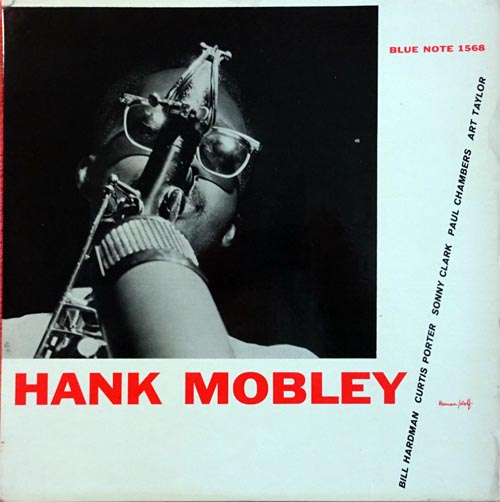 Hank Mobley – Hank Mobley Blue Note 1568 (1957) – $10,000 – Hank Mobley was a tenor saxophone player who had a long career, the early part of which was spent with Blue Note Records of New York City. Many of Blue Note’s releases from the 1950s have long been sought out by collectors, and first pressings of a number of their titles from the 1950s routinely sell for more than $1000.
Hank Mobley – Hank Mobley Blue Note 1568 (1957) – $10,000 – Hank Mobley was a tenor saxophone player who had a long career, the early part of which was spent with Blue Note Records of New York City. Many of Blue Note’s releases from the 1950s have long been sought out by collectors, and first pressings of a number of their titles from the 1950s routinely sell for more than $1000.
The most valuable of all of them is the self-titled Hank Mobley, released in 1956. Oddly enough, the album was Mobley’s sixth title for Blue Note, but for some reason, the first pressing of that album was quite small, with estimates that no more than 300-1000 copies were printed.
First pressings can be noted by a discrepancy in the record company’s address on the label; side one lists the city as “NYC,” while side two lists “New York 23.” For whatever reason, the album was not reissued after Blue Note was acquired by Liberty Records in the mid-1960s, making all copies of the album relatively rare compared to other Blue Note titles.
While Hank Mobley has long been a highly sought out album by fans of jazz and hard bop, in recent years, the price of the album has escalated dramatically. Copies often change hands for upwards of $5000, and in 2015, a buyer on eBay paid £7300 ($11,000 in 2018 dollars) for a pristine copy.
Copies with “NYC” on both sides also command high prices and sell for almost $5000 in mint condition.
Most Valuable Vinyl Records Conclusion
No list of the most valuable vinyl records can be either complete or definitive. Thousands of records are sold every day, and new high prices are established all the time. As we mentioned earlier, the true examples of the most valuable vinyl records are odd, one-of-a-kind items that likely come from the collection of either the artists themselves or high-ranking record company employees and are not the sorts of records that the layman is likely to encounter.
Others are obscure singles, either 45 or 78 RPM that were pressed by tiny regional labels or which were pressed by major record companies but withdrawn prior to release, with only a few copies “leaking out.”
In this listing of the most valuable vinyl records, we’ve tried to list albums only, as that’s what our site is about. We also tried to list only records that were sold commercially. Granted, they might have been available only in select regions or available only for a short period of time. In a couple of cases, they’re records that were released by accident using stampers that were mistakenly used at the pressing plant by employees that weren’t paying as much attention as they should have been.
Do you own one of these records? Frankly, it’s unlikely, but it’s not impossible. In our nearly 40 years of selling records, we’ve had exactly one of the records on this list – an “ad back” stereo copy of Introducing the Beatles.
Still, a big part of record collecting is the thrill of the chase and hunting down of rarities, and every one of the most valuable vinyl records listed here is something that someone, somewhere, might possibly encounter in going through a box of used records at a yard sale, a thrift store or even a record shop.
LIkely? No, but the unlikely happens every day. Good luck!











